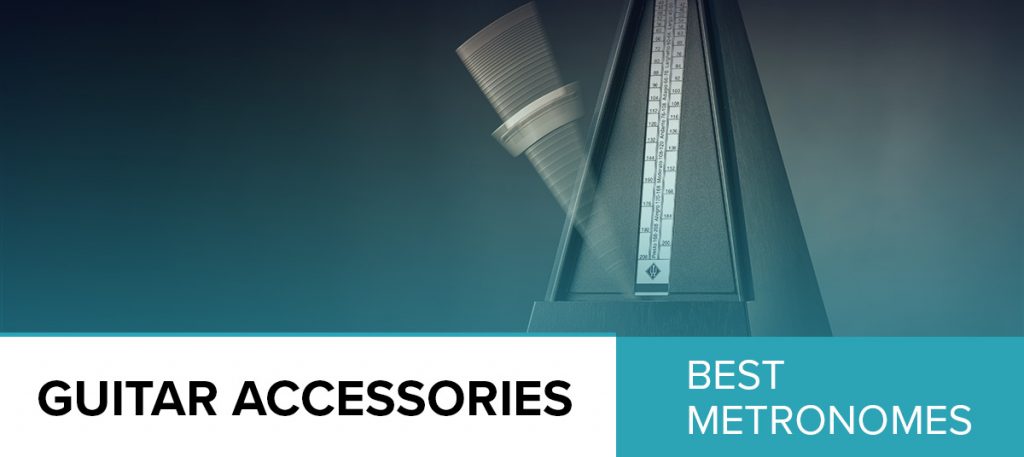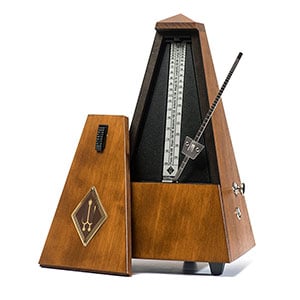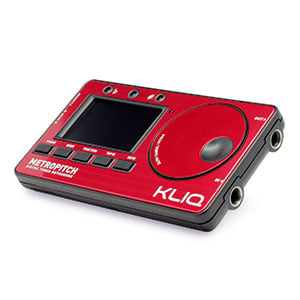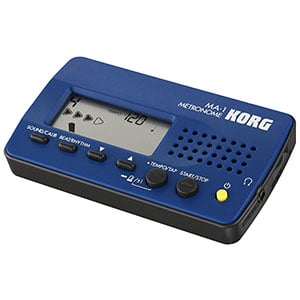6 Best Metronomes – The Importance Of Timing
We may also earn commissions on purchases from other retail websites.

Music is one of those activities most enjoy and many like to take up. Some choose to get formal education, but some head in on their own. While bootstrapping your way through learning an instrument is an awesome experience, a good amount of learners fail to understand the importance of good timing. Being able to play within a tempo is essential for any kind of music. Even those songs that sound offbeat are actually following a beat of some sort. Today we're going to talk about metronomes, which are the main tool used to learn how to keep good timing.
6 Best Metronomes To Consider
| Image | Metronome / Rating | Summary | Check Price |
|---|---|---|---|
+ -  | Wittner 813M Total of 4.65/5 | One of the best value for the money mechanical models currently available. | |
+ -  | Korg TMR50 Total of 4.63/5 | A great digital unit with versatile features packed in a portable format. | |
+ -  | Wittner WIT864062 Total of 4.55/5 | High quality digital quartz model which combines modern and old school solutions. | |
+ -  | Cherub Metronome WSM330 Total of 4.25/5 | An effective and inexpensive alternative for those who want a mechanical metronome. | |
+ -  | KLIQ MetroPitch Total of 4.07/5 | Compact tuner with a built in metronome that goes beyond basic functions. | |
+ -  | Korg MA1BL Visual Beat Counting Metronome Total of 3.80/5 | One of the smallest and cheapest metronomes that offers the necessary performance. |
Wittner 813M

| Design: |  |
| Features: |  |
| Performance: |  |
| Value: |  |
Mechanical metronomes have been the core of musician's accessories for centuries. So much so that we see them being widely used even today. Wittner 813M is one of the best models of this type that can still be considered as affordable.
You are looking at a fine, full wood body that features a mat silk and built in bell. Aside from its classic feel and aesthetics, Wittner 813M offers an extremely accurate tempo tracking. The mechanism itself is rather sturdy considering how accurate it is.
When it comes to mechanical metronomes, this one absolutely proves that a swinging pendulum might still be the way to go. Best of all, it is extremely easy to use and delivers long lasting sessions.
Korg TMR50

| Design: |  |
| Features: |  |
| Performance: |  |
| Value: |  |
In the world of dedicated devices, Korg TMR50 represents a whole new breed. This isn't just a metronome. Instead, it is a tuner as well as a recorder. The first thing you will notice is just how compact TMR50 is.
Despite being full of useful features, it is still small enough to be stored in your gig bag without adding too much weight. Speaking of features, you can use all three primary functions at the same time should you choose to.
The metronome mode allows you to select different beats but also input a manual one via tap tempo feature. If you are looking for a one stop shop for tuning, tempo practice and recording, Korg TMR50 is definitely it.
Wittner WIT864062

| Design: |  |
| Features: |  |
| Performance: |  |
| Value: |  |
In a market populated by modern digital and old school mechanical metronomes, Wittner WIT864062 finds itself somewhere in the middle. It is a digital quartz unit that combines the classic tone of a mechanical unit with the compact size of digital metronomes.
This model comes in a high quality wooden body that has been made to fit tight tolerances. On the front, you will find the main dial used to set the desired temp.
There is also an array of LED lights which are used to deliver a visual tempo simulation on top of the audible beat. Overall, it is a great choice for those who dislike the clinically sharp beeping of digital units, but require something that's highly portable.
Cherub Metronome WSM330

| Design: |  |
| Features: |  |
| Performance: |  |
| Value: |  |
Mechanical metronomes are still the norm. However, they're often pretty expensive. Cherub WSM330 offers a solution that might mitigate the issue of price. It's a classic mechanical model, but it comes packed in a plastic body.
In terms of tempo tolerance, WSM330 is extremely accurate. The range of tempos available goes from 40 all the way to 208, which is more than enough for beginners and intermediate users. Despite its plastic body, this metronome features a very well made metal mechanism.
Aside from being accurate, said mechanism also brings you that authentic sound of a mechanical metronome. If you're after that classic feel and aesthetic of a mechanical unit, but you're on a tight budget, this is a great solution.
KLIQ MetroPitch

| Design: |  |
| Features: |  |
| Performance: |  |
| Value: |  |
Portable format is often times a deciding factor when it comes to metronomes. Finding a good, compact digital unit is a great way to practice on the go, but also have a solid backup. KLIQ MetroPitch fits this description perfectly.
It is a metronome/tuner combo that is packed in a very small chassis. Compared to more advanced models, it may lack some features. However, it also fits in your pocket. The best thing about KLIQ MetroPitch is just how versatile it is.
You can set tempo anywhere from 30 beats per minute, to 250. There is also a tap tempo feature and a number of built in beats for you to explore. At this price, it is a bargain.
Korg MA1BL Visual Beat Counting Metronome

| Design: |  |
| Features: |  |
| Performance: |  |
| Value: |  |
Small, inexpensive and practical metronomes are becoming more and more popular. Korg's MA1LB is a great example of such a model. It comes in a slim body that features a small display and several buttons.
Aside from allowing you to hear the tempo, Korg MA1LB also offers a visual counter. You can set tempos that range from 30 to 252 beats per minute and have them in three different modes. These include full steps, tap temp input and pendulum steps.
On top of that, Korg has programmed several beats as well as patters. Those who are looking for a reliable and cheap metronome for daily use should look no further. Korg MA1LB is the ultimate bang for the buck choice.
The Importance Of Good Timing
Those who aren't into music rarely think about timing and just what kind of impact it can have on any piece of music. If you have several musicians in a room, trying to play a piece together, itis imperative that all of them are on the same page in terms of tempo. Otherwise, that particular song simply won't sound right. One would think that missing the beat is an issue in smaller bands, but one instrument out of tempo can cause problems even for philharmonic orchestras.
Learning how to keep a tempo can be easy or hard, depending on your given sense for rhythm. Some people need very little training to bring that sense where it needs to be, but some absolutely need that training if they are serious about playing music. Interestingly enough, no one really knows just how good or bad they are until they sit down and play along a metronome. This phenomenon is also the reason why metronomes are an essential piece of kit in every music school.
One of the best things you can do as someone who's just getting into a particular instrument is to get a good metronome. You might hate it at first, but you will quickly find out just how valuable these things are. That value is so much higher for percussionists, seeing how they are often the ones who dictate the tempo for the rest of the band.
What Are Metronomes?
In simple terms, metronomes are devices which lay down a perfectly timed beat. There are several different kinds, which we will touch upon later, but they all do the same job. Some musicians are surprised when they find out that metronomes were used for centuries. Names such as Beethoven and other composers, used these tools to write music.
As we have said before, metronomes come in a variety of formats. The oldest one is a mechanical metronome, which is also what most people associate with this term. Then we have more modern digital metronomes, and finally the apps that turn your smart device into a metronome. No matter which one you choose, you will learn that metronomes, much like guitar tuners, are a valuable tool to have. Lets check out different types of metronomes and see what each as to offer.
Mechanical Metronomes
Mechanical models are the oldest ones. They have been used for centuries and have stuck around until today. A mechanical metronome is easy to spot as it has a uniquely styled body that looks like a pyramid. If you need a quick visual, just check out Wittner 813M. What makes mechanical models so convenient is the fact that they require no power whatsoever. Instead, they are wound. On the front end, you will see a bar with a weight. Moving that weight up and down the bar will determine the tempo. One of the most common misconceptions about a mechanical metronome is that it runs out fairly quickly. That is anything but true. An average mechanical model will last longer than even the most hard core practice sessions do.
When it comes to the down sides, there are few. For starters, mechanical models are usually not cheap. If you want a good one, you will have to invest some money. There are models such as the Cherub WSM330, although they are an exception to the rule. The other disadvantage to using a mechanical unit is the fact that you need to have it on a flat surface. Otherwise its performance can be negatively affected. Even so, mechanical models are still considered to be the go to choice for many.
Digital Metronomes
Once you enter the digital side of the family, things tend to get a lot more complex. Digital metronomes are naturally the more modern type, and they come in all sorts of formats and configuration. On the top of the line, you will find units such as the BOSS DB90. This thing is so much more than just a simple metronome. It is a device that allows you to use different beats, access various presets and do much more than just follow a simple tempo. Similar goes for Korg TMR50. On the other end of the extreme, we have models such as Korg MA1BL. This tiny device is much more basic in its nature, but is much more portable that the previous models we have mentioned. This is the type of model you can carry with you wherever you go.
The main benefit of digital metronomes is the fact that they are independent of the environment they are in. Sure, they require a power source, but you won't feel limited at all. If you add a power adapter into the mix, the issue of power becomes much easier to handle. Another benefit is the fact that you can have more than just a metronome in there. For example, a lot of these have a built in tuner, like the KLIQ MetroPitch. Those looking for a digital model, but one that is a bit more traditional, usually go for dial digital metronomes. Wittner WIT864062 is a good example of this.
Software Apps
Seeing how we live in an age where mobile devices are becoming more and more practical, it isn't that strange to find metronome apps. There are many of them out there, and they sure are convenient. If you think about it, mobile phones are the one thing most of us always have by our side.
Best Metronomes For Piano
Generally speaking you can use any kind of metronome with any kind of instrument. While they might get the job done in slightly different ways, they all deliver the same results. However, since a piano isn't really something you are going to be moving all that often, you might want to find yourself a great mechanical metronome like the one on our list above. It's a great solution that requires no batteries, thus allowing you to practice without any hassle.
One more often overseen reason why mechanical models are a great choice for a piano, is their sound. A piano is one of the oldest acoustic instrument we use today. Running a digital click track while you practice may be every bit as practical, but it definitely takes away from the sound of a piano. On the other hand, the mechanical tone of a moving pendulum fits right in. With that said, it all comes down to personal preference at the end of the day.
Best Metronomes For Guitar
With guitars, the situation is ever so slightly different. Most guitar players prefer to have a metronome that they can take with them. A smaller digital unit can be a great choice. All you have to do is drop it in your gig bag and you will have it at your disposal at any time. One logical question that comes up often is how to deal with metronomes when you are pushing a high gain distortion through your signal chain? There are several answers for this, some of which suggest that you don't actually use distortion. On the other hand, you can always go for a visual metronome. These are most often digital and have a visual representation of the tempo in addition to the auditory one.
How To Choose The Right Metronome?
Finding the right model for your needs is very similar to finding the right guitar strap for your guitar. It all comes down to personal taste. Just about every metronome out there will provide you with the most basic function. However, that doesn't mean that you can't get something more. Some models include many additional functions such as different beats, built in tuners and similar features. Those will tend to cost a bit more, but that is the price of convenience. At the end of the day, any metronome is better than none.
How To Practice And Play Music With A Metronome
If we start with an assumption that you are a beginner guitar player who has just bought their first metronome, how exactly would you go around using it? As much as it is important to incorporate this piece of equipment into your routine, there are some thing that you need to cover before you get there. For starters, you will want to develop your technique to a point where you are comfortable playing without missing notes. In context of guitar, you should be comfortable with the fretboard and your picking skills.
This is where a metronome should be added to the mix. One of the worst and most common mistakes among beginners is the wish to shred scales right away. The notion that being able to pick a note somehow means you can do it fast has disappointed many novice musicians. In reality, the key is to start slow. How slow? Somewhere around 90 beats per minute is a good place to start. If you feel like you are wasting your time and that it's too easy, try to suppress the temptation of bumping that temp higher. Mastering rhythm isn't about how well you can follow a specific temp for a short amount of time. Rather, it is about your ability to do so for longer periods. The next step is simple. Keep bumping that tempo higher in small increments. Over time, you will not only play faster, but your timing will be spot on no matter the speed.
What Happens When You Hit That Speed Ceiling?
Hitting a performance ceiling is a completely normal thing. This means that you have found your current limit, which you need to break through. The thing is, without a metronome, you probably wouldn't have recognized that limit for what it is. Most people hit it and then have a natural tendency to dial thing down a bit. When you are practicing without a metronome, you will hardly notice this. However, when you shop for band practice, don't be surprised when everyone else is on point and you are falling behind. Breaking those limits is all about practice. There are no shortcut. All you have to do is set spend time working on your speed and of course, use a metronome. Truth is that building speed takes the same amount of time and effort as developing proper technique.
Conclusion
Learning how to play in tempo and developing an inner sense for timing is easily one of the most valuable skills a musician can have. The tools we have discussed today are the only reliable way to achieve that. Hopefully, today we have proven to you that metronomes are neither complicated nor necessarily expensive. After a while, you will be using one without even noticing it is there. As you progress your skills, this seemingly simple piece of kit will expand your horizons, help you master complicated beats and give you an insight into music like you've never had before.




Reader Interactions